HSBC Bank: A Case Study on Restructuring the HR Department
VerifiedAdded on 2024/05/30
|18
|4951
|122
Case Study
AI Summary
This case study report examines the restructuring of the Human Resource department at HSBC Bank, a prominent global financial institution. It begins with an overview of HSBC, highlighting its global presence, organizational structure, and commitment to leadership. The report assesses the purpose, key roles, and responsibilities of the HR function within HSBC, emphasizing its role in aligning the workforce with strategic objectives through talent, knowledge, and performance management. It evaluates HSBC's approach to workforce planning, recruitment, and selection, recommending refinements to ensure the attraction and retention of qualified individuals while complying with labor laws. Furthermore, the report discusses the importance of training and development, organizational culture, and employee relations in enhancing workforce performance. Finally, the report analyzes the internal and external factors, such as Brexit, that affect HRM decision-making at HSBC, underscoring the need for continuous restructuring to maintain competitiveness. Desklib provides access to this and other solved assignments for students.
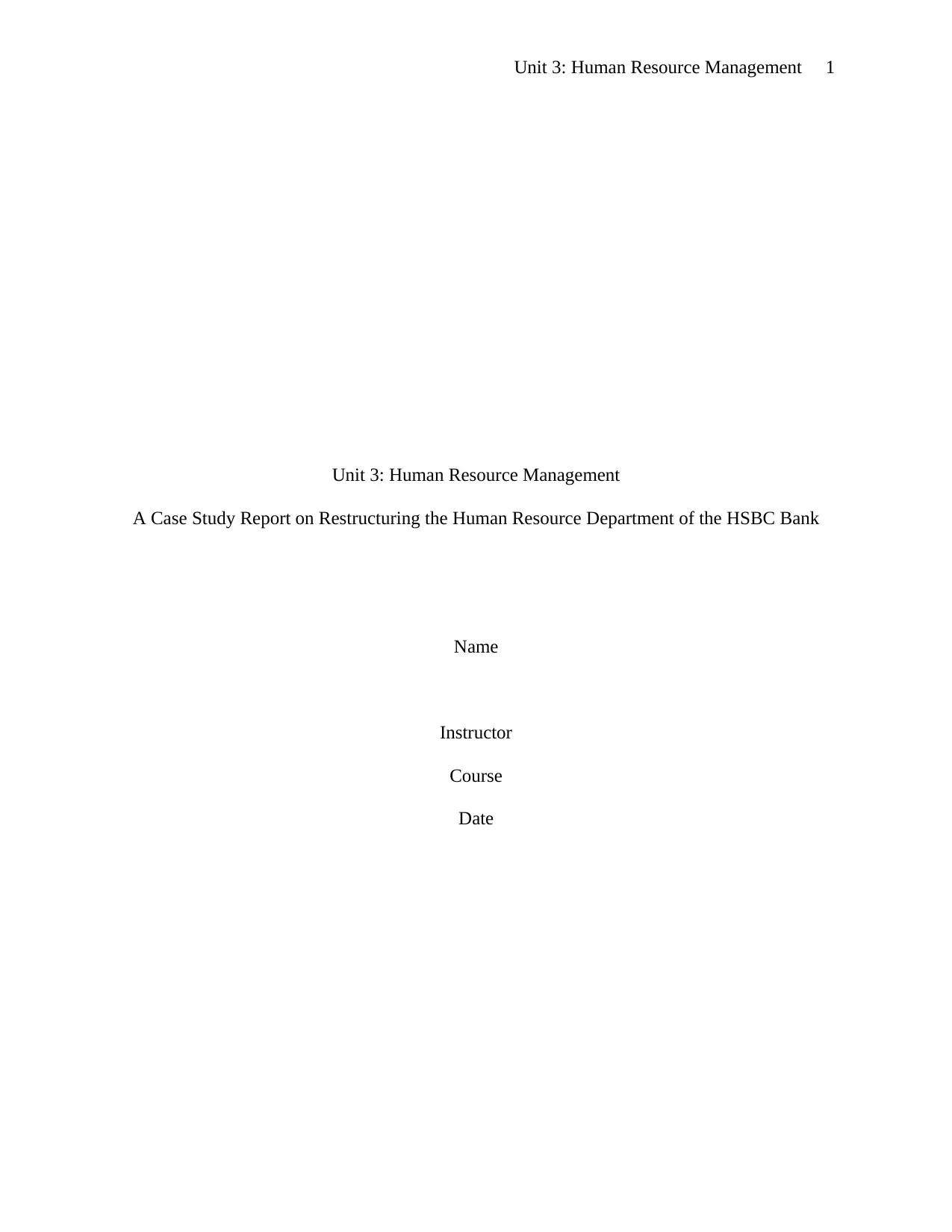
Unit 3: Human Resource Management 1
Unit 3: Human Resource Management
A Case Study Report on Restructuring the Human Resource Department of the HSBC Bank
Name
Instructor
Course
Date
Unit 3: Human Resource Management
A Case Study Report on Restructuring the Human Resource Department of the HSBC Bank
Name
Instructor
Course
Date
Paraphrase This Document
Need a fresh take? Get an instant paraphrase of this document with our AI Paraphraser
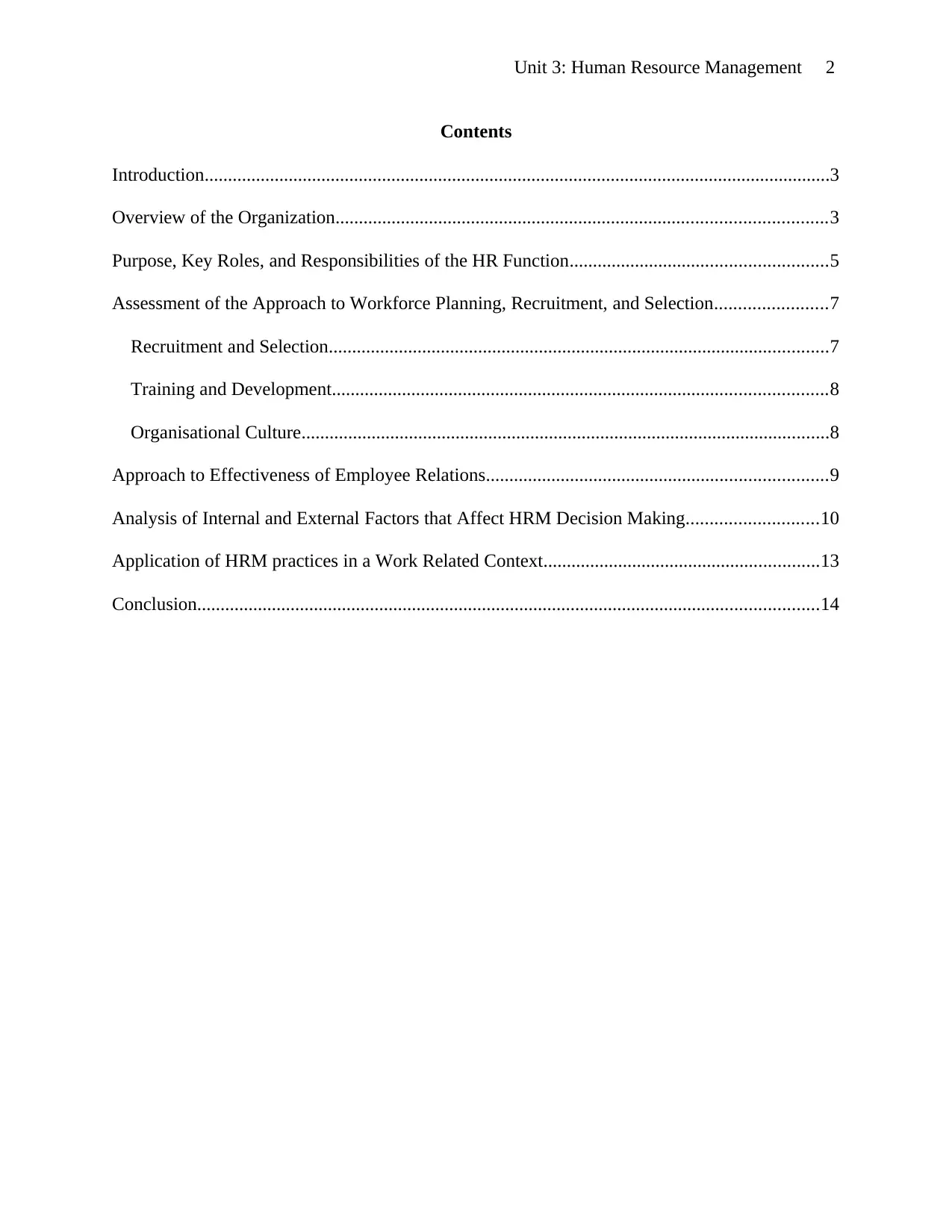
Unit 3: Human Resource Management 2
Contents
Introduction......................................................................................................................................3
Overview of the Organization.........................................................................................................3
Purpose, Key Roles, and Responsibilities of the HR Function.......................................................5
Assessment of the Approach to Workforce Planning, Recruitment, and Selection........................7
Recruitment and Selection...........................................................................................................7
Training and Development..........................................................................................................8
Organisational Culture.................................................................................................................8
Approach to Effectiveness of Employee Relations.........................................................................9
Analysis of Internal and External Factors that Affect HRM Decision Making............................10
Application of HRM practices in a Work Related Context...........................................................13
Conclusion.....................................................................................................................................14
Contents
Introduction......................................................................................................................................3
Overview of the Organization.........................................................................................................3
Purpose, Key Roles, and Responsibilities of the HR Function.......................................................5
Assessment of the Approach to Workforce Planning, Recruitment, and Selection........................7
Recruitment and Selection...........................................................................................................7
Training and Development..........................................................................................................8
Organisational Culture.................................................................................................................8
Approach to Effectiveness of Employee Relations.........................................................................9
Analysis of Internal and External Factors that Affect HRM Decision Making............................10
Application of HRM practices in a Work Related Context...........................................................13
Conclusion.....................................................................................................................................14
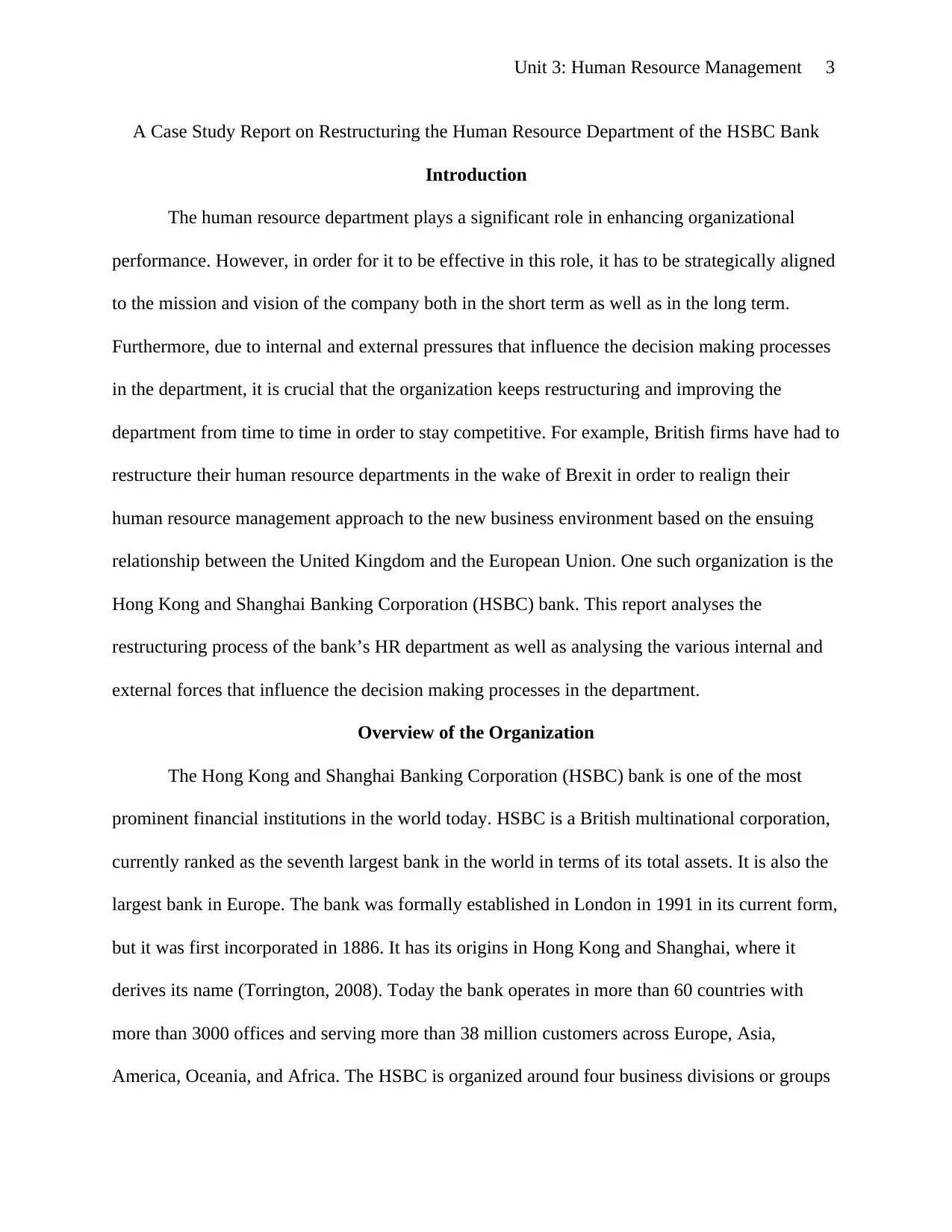
Unit 3: Human Resource Management 3
A Case Study Report on Restructuring the Human Resource Department of the HSBC Bank
Introduction
The human resource department plays a significant role in enhancing organizational
performance. However, in order for it to be effective in this role, it has to be strategically aligned
to the mission and vision of the company both in the short term as well as in the long term.
Furthermore, due to internal and external pressures that influence the decision making processes
in the department, it is crucial that the organization keeps restructuring and improving the
department from time to time in order to stay competitive. For example, British firms have had to
restructure their human resource departments in the wake of Brexit in order to realign their
human resource management approach to the new business environment based on the ensuing
relationship between the United Kingdom and the European Union. One such organization is the
Hong Kong and Shanghai Banking Corporation (HSBC) bank. This report analyses the
restructuring process of the bank’s HR department as well as analysing the various internal and
external forces that influence the decision making processes in the department.
Overview of the Organization
The Hong Kong and Shanghai Banking Corporation (HSBC) bank is one of the most
prominent financial institutions in the world today. HSBC is a British multinational corporation,
currently ranked as the seventh largest bank in the world in terms of its total assets. It is also the
largest bank in Europe. The bank was formally established in London in 1991 in its current form,
but it was first incorporated in 1886. It has its origins in Hong Kong and Shanghai, where it
derives its name (Torrington, 2008). Today the bank operates in more than 60 countries with
more than 3000 offices and serving more than 38 million customers across Europe, Asia,
America, Oceania, and Africa. The HSBC is organized around four business divisions or groups
A Case Study Report on Restructuring the Human Resource Department of the HSBC Bank
Introduction
The human resource department plays a significant role in enhancing organizational
performance. However, in order for it to be effective in this role, it has to be strategically aligned
to the mission and vision of the company both in the short term as well as in the long term.
Furthermore, due to internal and external pressures that influence the decision making processes
in the department, it is crucial that the organization keeps restructuring and improving the
department from time to time in order to stay competitive. For example, British firms have had to
restructure their human resource departments in the wake of Brexit in order to realign their
human resource management approach to the new business environment based on the ensuing
relationship between the United Kingdom and the European Union. One such organization is the
Hong Kong and Shanghai Banking Corporation (HSBC) bank. This report analyses the
restructuring process of the bank’s HR department as well as analysing the various internal and
external forces that influence the decision making processes in the department.
Overview of the Organization
The Hong Kong and Shanghai Banking Corporation (HSBC) bank is one of the most
prominent financial institutions in the world today. HSBC is a British multinational corporation,
currently ranked as the seventh largest bank in the world in terms of its total assets. It is also the
largest bank in Europe. The bank was formally established in London in 1991 in its current form,
but it was first incorporated in 1886. It has its origins in Hong Kong and Shanghai, where it
derives its name (Torrington, 2008). Today the bank operates in more than 60 countries with
more than 3000 offices and serving more than 38 million customers across Europe, Asia,
America, Oceania, and Africa. The HSBC is organized around four business divisions or groups
⊘ This is a preview!⊘
Do you want full access?
Subscribe today to unlock all pages.

Trusted by 1+ million students worldwide
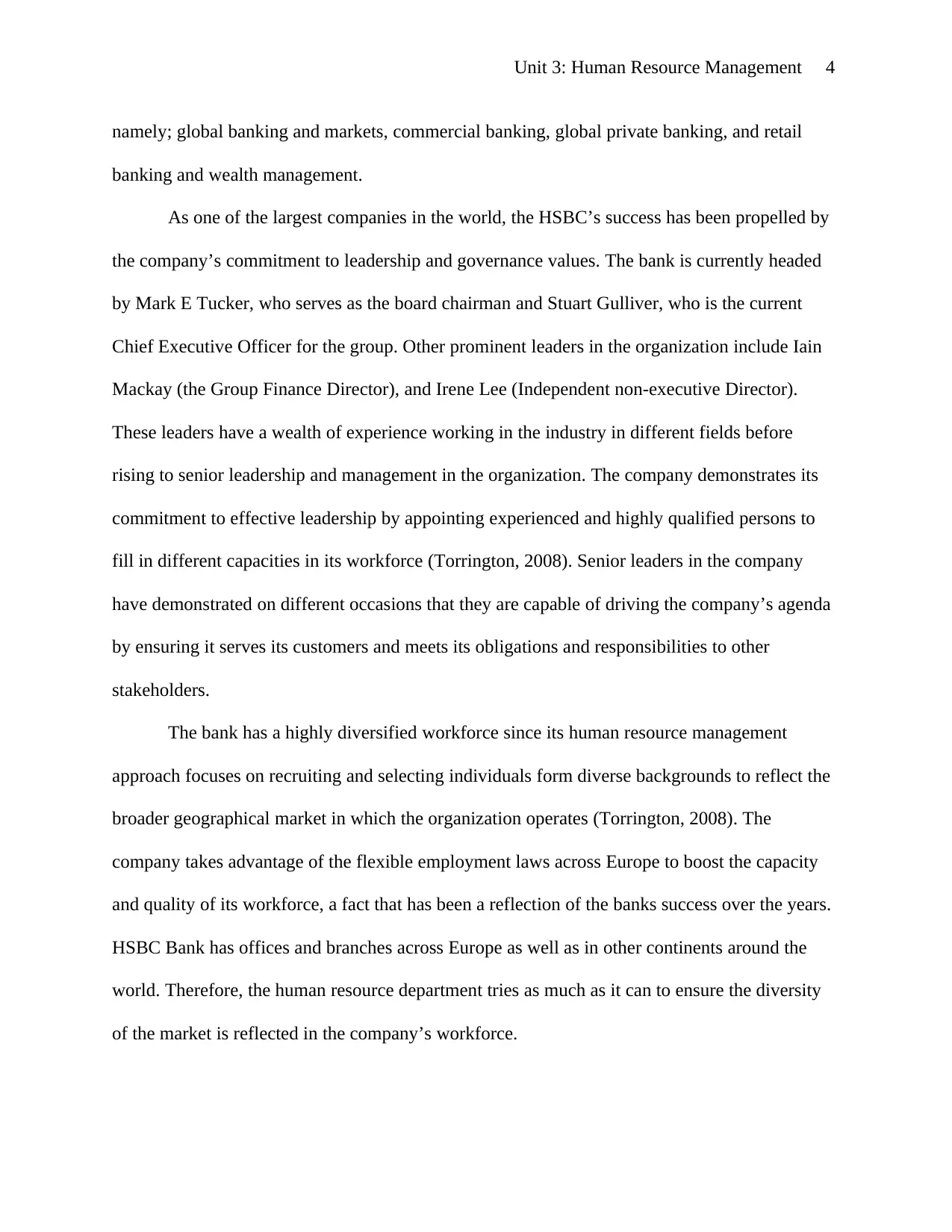
Unit 3: Human Resource Management 4
namely; global banking and markets, commercial banking, global private banking, and retail
banking and wealth management.
As one of the largest companies in the world, the HSBC’s success has been propelled by
the company’s commitment to leadership and governance values. The bank is currently headed
by Mark E Tucker, who serves as the board chairman and Stuart Gulliver, who is the current
Chief Executive Officer for the group. Other prominent leaders in the organization include Iain
Mackay (the Group Finance Director), and Irene Lee (Independent non-executive Director).
These leaders have a wealth of experience working in the industry in different fields before
rising to senior leadership and management in the organization. The company demonstrates its
commitment to effective leadership by appointing experienced and highly qualified persons to
fill in different capacities in its workforce (Torrington, 2008). Senior leaders in the company
have demonstrated on different occasions that they are capable of driving the company’s agenda
by ensuring it serves its customers and meets its obligations and responsibilities to other
stakeholders.
The bank has a highly diversified workforce since its human resource management
approach focuses on recruiting and selecting individuals form diverse backgrounds to reflect the
broader geographical market in which the organization operates (Torrington, 2008). The
company takes advantage of the flexible employment laws across Europe to boost the capacity
and quality of its workforce, a fact that has been a reflection of the banks success over the years.
HSBC Bank has offices and branches across Europe as well as in other continents around the
world. Therefore, the human resource department tries as much as it can to ensure the diversity
of the market is reflected in the company’s workforce.
namely; global banking and markets, commercial banking, global private banking, and retail
banking and wealth management.
As one of the largest companies in the world, the HSBC’s success has been propelled by
the company’s commitment to leadership and governance values. The bank is currently headed
by Mark E Tucker, who serves as the board chairman and Stuart Gulliver, who is the current
Chief Executive Officer for the group. Other prominent leaders in the organization include Iain
Mackay (the Group Finance Director), and Irene Lee (Independent non-executive Director).
These leaders have a wealth of experience working in the industry in different fields before
rising to senior leadership and management in the organization. The company demonstrates its
commitment to effective leadership by appointing experienced and highly qualified persons to
fill in different capacities in its workforce (Torrington, 2008). Senior leaders in the company
have demonstrated on different occasions that they are capable of driving the company’s agenda
by ensuring it serves its customers and meets its obligations and responsibilities to other
stakeholders.
The bank has a highly diversified workforce since its human resource management
approach focuses on recruiting and selecting individuals form diverse backgrounds to reflect the
broader geographical market in which the organization operates (Torrington, 2008). The
company takes advantage of the flexible employment laws across Europe to boost the capacity
and quality of its workforce, a fact that has been a reflection of the banks success over the years.
HSBC Bank has offices and branches across Europe as well as in other continents around the
world. Therefore, the human resource department tries as much as it can to ensure the diversity
of the market is reflected in the company’s workforce.
Paraphrase This Document
Need a fresh take? Get an instant paraphrase of this document with our AI Paraphraser
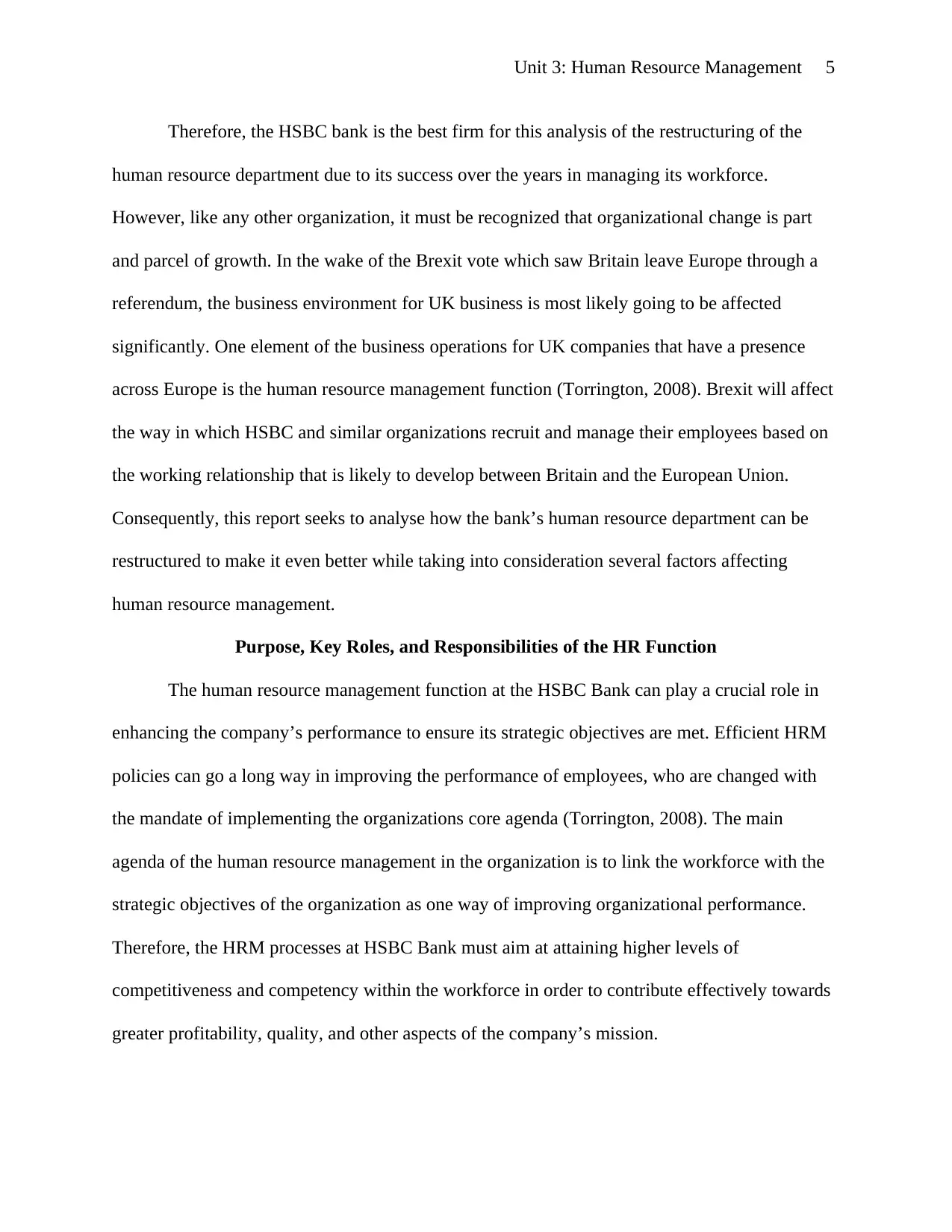
Unit 3: Human Resource Management 5
Therefore, the HSBC bank is the best firm for this analysis of the restructuring of the
human resource department due to its success over the years in managing its workforce.
However, like any other organization, it must be recognized that organizational change is part
and parcel of growth. In the wake of the Brexit vote which saw Britain leave Europe through a
referendum, the business environment for UK business is most likely going to be affected
significantly. One element of the business operations for UK companies that have a presence
across Europe is the human resource management function (Torrington, 2008). Brexit will affect
the way in which HSBC and similar organizations recruit and manage their employees based on
the working relationship that is likely to develop between Britain and the European Union.
Consequently, this report seeks to analyse how the bank’s human resource department can be
restructured to make it even better while taking into consideration several factors affecting
human resource management.
Purpose, Key Roles, and Responsibilities of the HR Function
The human resource management function at the HSBC Bank can play a crucial role in
enhancing the company’s performance to ensure its strategic objectives are met. Efficient HRM
policies can go a long way in improving the performance of employees, who are changed with
the mandate of implementing the organizations core agenda (Torrington, 2008). The main
agenda of the human resource management in the organization is to link the workforce with the
strategic objectives of the organization as one way of improving organizational performance.
Therefore, the HRM processes at HSBC Bank must aim at attaining higher levels of
competitiveness and competency within the workforce in order to contribute effectively towards
greater profitability, quality, and other aspects of the company’s mission.
Therefore, the HSBC bank is the best firm for this analysis of the restructuring of the
human resource department due to its success over the years in managing its workforce.
However, like any other organization, it must be recognized that organizational change is part
and parcel of growth. In the wake of the Brexit vote which saw Britain leave Europe through a
referendum, the business environment for UK business is most likely going to be affected
significantly. One element of the business operations for UK companies that have a presence
across Europe is the human resource management function (Torrington, 2008). Brexit will affect
the way in which HSBC and similar organizations recruit and manage their employees based on
the working relationship that is likely to develop between Britain and the European Union.
Consequently, this report seeks to analyse how the bank’s human resource department can be
restructured to make it even better while taking into consideration several factors affecting
human resource management.
Purpose, Key Roles, and Responsibilities of the HR Function
The human resource management function at the HSBC Bank can play a crucial role in
enhancing the company’s performance to ensure its strategic objectives are met. Efficient HRM
policies can go a long way in improving the performance of employees, who are changed with
the mandate of implementing the organizations core agenda (Torrington, 2008). The main
agenda of the human resource management in the organization is to link the workforce with the
strategic objectives of the organization as one way of improving organizational performance.
Therefore, the HRM processes at HSBC Bank must aim at attaining higher levels of
competitiveness and competency within the workforce in order to contribute effectively towards
greater profitability, quality, and other aspects of the company’s mission.
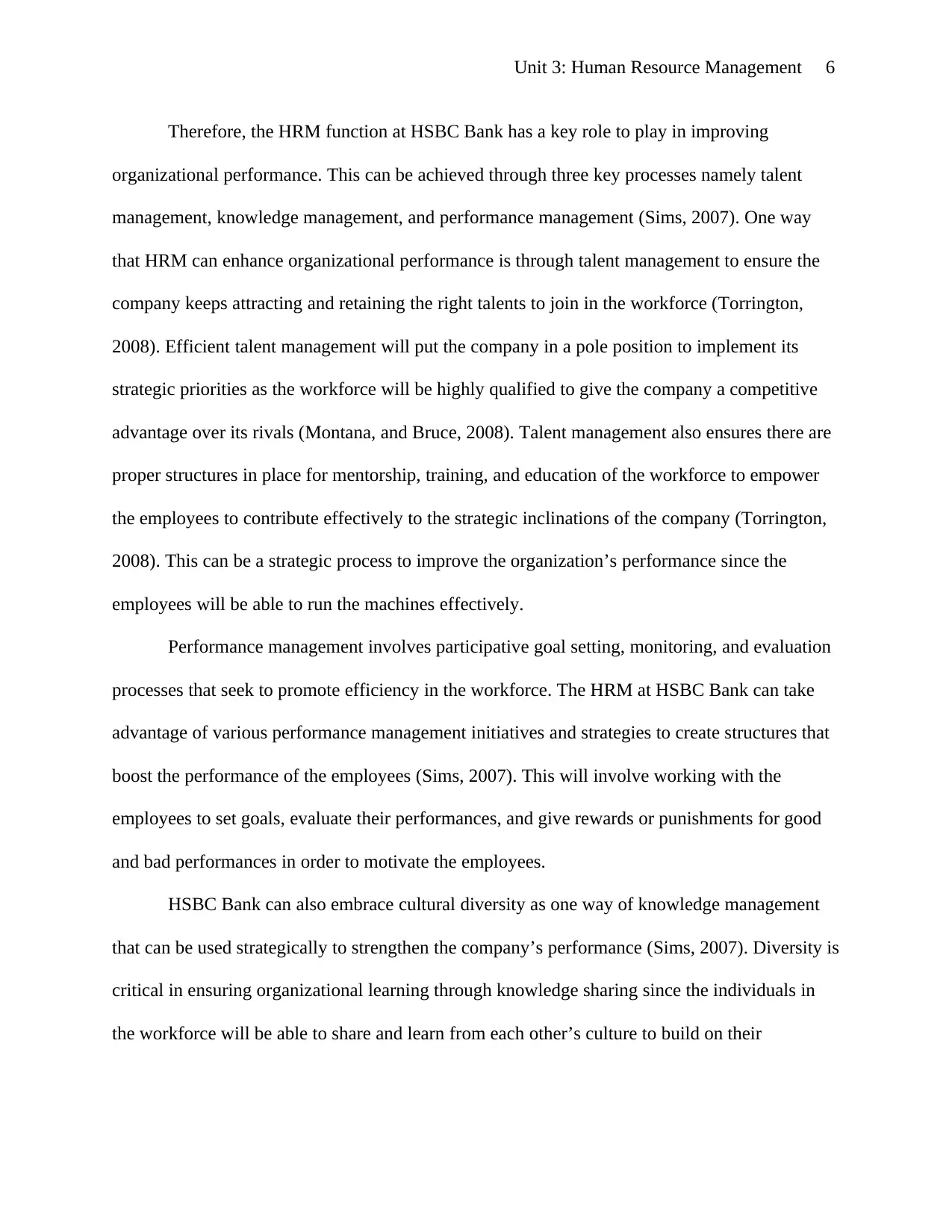
Unit 3: Human Resource Management 6
Therefore, the HRM function at HSBC Bank has a key role to play in improving
organizational performance. This can be achieved through three key processes namely talent
management, knowledge management, and performance management (Sims, 2007). One way
that HRM can enhance organizational performance is through talent management to ensure the
company keeps attracting and retaining the right talents to join in the workforce (Torrington,
2008). Efficient talent management will put the company in a pole position to implement its
strategic priorities as the workforce will be highly qualified to give the company a competitive
advantage over its rivals (Montana, and Bruce, 2008). Talent management also ensures there are
proper structures in place for mentorship, training, and education of the workforce to empower
the employees to contribute effectively to the strategic inclinations of the company (Torrington,
2008). This can be a strategic process to improve the organization’s performance since the
employees will be able to run the machines effectively.
Performance management involves participative goal setting, monitoring, and evaluation
processes that seek to promote efficiency in the workforce. The HRM at HSBC Bank can take
advantage of various performance management initiatives and strategies to create structures that
boost the performance of the employees (Sims, 2007). This will involve working with the
employees to set goals, evaluate their performances, and give rewards or punishments for good
and bad performances in order to motivate the employees.
HSBC Bank can also embrace cultural diversity as one way of knowledge management
that can be used strategically to strengthen the company’s performance (Sims, 2007). Diversity is
critical in ensuring organizational learning through knowledge sharing since the individuals in
the workforce will be able to share and learn from each other’s culture to build on their
Therefore, the HRM function at HSBC Bank has a key role to play in improving
organizational performance. This can be achieved through three key processes namely talent
management, knowledge management, and performance management (Sims, 2007). One way
that HRM can enhance organizational performance is through talent management to ensure the
company keeps attracting and retaining the right talents to join in the workforce (Torrington,
2008). Efficient talent management will put the company in a pole position to implement its
strategic priorities as the workforce will be highly qualified to give the company a competitive
advantage over its rivals (Montana, and Bruce, 2008). Talent management also ensures there are
proper structures in place for mentorship, training, and education of the workforce to empower
the employees to contribute effectively to the strategic inclinations of the company (Torrington,
2008). This can be a strategic process to improve the organization’s performance since the
employees will be able to run the machines effectively.
Performance management involves participative goal setting, monitoring, and evaluation
processes that seek to promote efficiency in the workforce. The HRM at HSBC Bank can take
advantage of various performance management initiatives and strategies to create structures that
boost the performance of the employees (Sims, 2007). This will involve working with the
employees to set goals, evaluate their performances, and give rewards or punishments for good
and bad performances in order to motivate the employees.
HSBC Bank can also embrace cultural diversity as one way of knowledge management
that can be used strategically to strengthen the company’s performance (Sims, 2007). Diversity is
critical in ensuring organizational learning through knowledge sharing since the individuals in
the workforce will be able to share and learn from each other’s culture to build on their
⊘ This is a preview!⊘
Do you want full access?
Subscribe today to unlock all pages.

Trusted by 1+ million students worldwide
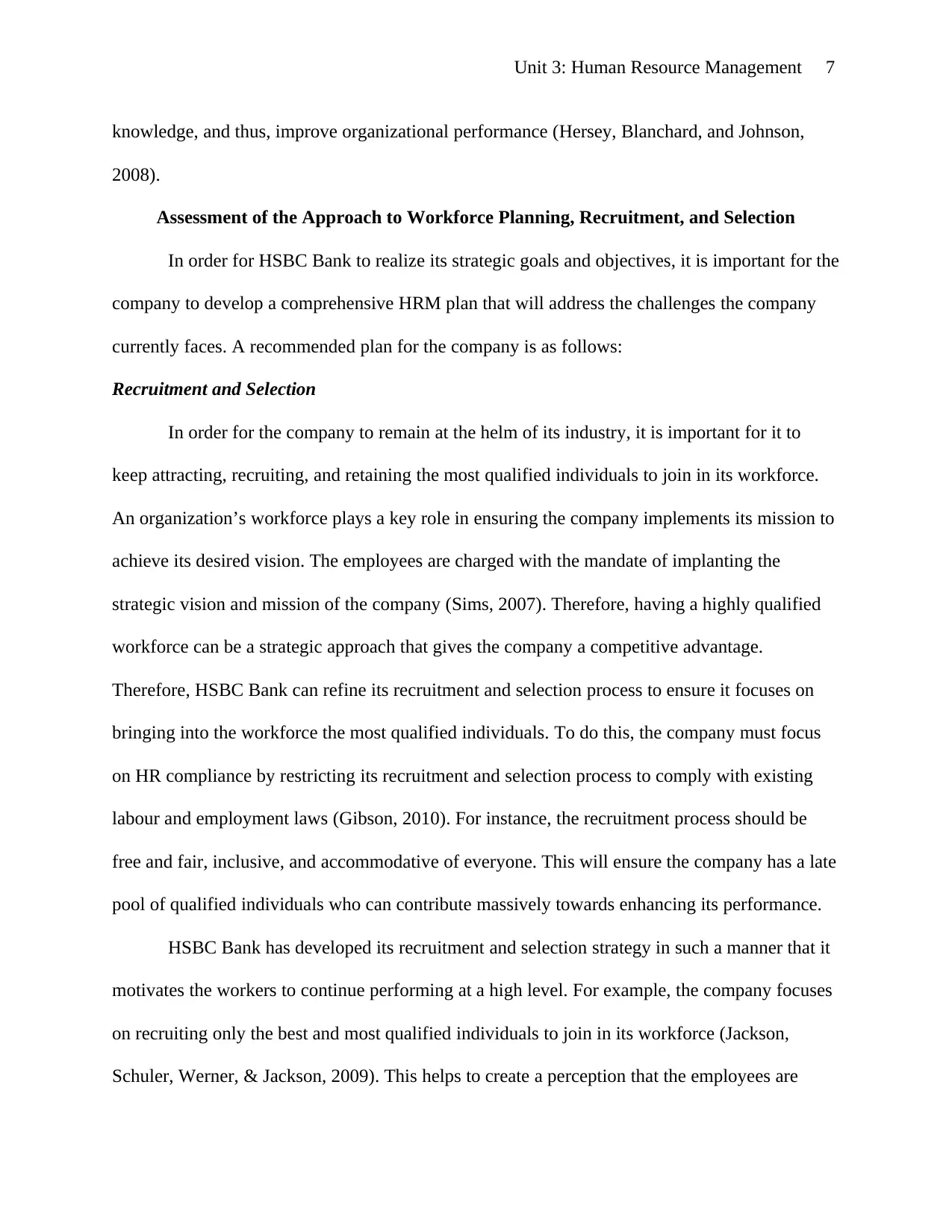
Unit 3: Human Resource Management 7
knowledge, and thus, improve organizational performance (Hersey, Blanchard, and Johnson,
2008).
Assessment of the Approach to Workforce Planning, Recruitment, and Selection
In order for HSBC Bank to realize its strategic goals and objectives, it is important for the
company to develop a comprehensive HRM plan that will address the challenges the company
currently faces. A recommended plan for the company is as follows:
Recruitment and Selection
In order for the company to remain at the helm of its industry, it is important for it to
keep attracting, recruiting, and retaining the most qualified individuals to join in its workforce.
An organization’s workforce plays a key role in ensuring the company implements its mission to
achieve its desired vision. The employees are charged with the mandate of implanting the
strategic vision and mission of the company (Sims, 2007). Therefore, having a highly qualified
workforce can be a strategic approach that gives the company a competitive advantage.
Therefore, HSBC Bank can refine its recruitment and selection process to ensure it focuses on
bringing into the workforce the most qualified individuals. To do this, the company must focus
on HR compliance by restricting its recruitment and selection process to comply with existing
labour and employment laws (Gibson, 2010). For instance, the recruitment process should be
free and fair, inclusive, and accommodative of everyone. This will ensure the company has a late
pool of qualified individuals who can contribute massively towards enhancing its performance.
HSBC Bank has developed its recruitment and selection strategy in such a manner that it
motivates the workers to continue performing at a high level. For example, the company focuses
on recruiting only the best and most qualified individuals to join in its workforce (Jackson,
Schuler, Werner, & Jackson, 2009). This helps to create a perception that the employees are
knowledge, and thus, improve organizational performance (Hersey, Blanchard, and Johnson,
2008).
Assessment of the Approach to Workforce Planning, Recruitment, and Selection
In order for HSBC Bank to realize its strategic goals and objectives, it is important for the
company to develop a comprehensive HRM plan that will address the challenges the company
currently faces. A recommended plan for the company is as follows:
Recruitment and Selection
In order for the company to remain at the helm of its industry, it is important for it to
keep attracting, recruiting, and retaining the most qualified individuals to join in its workforce.
An organization’s workforce plays a key role in ensuring the company implements its mission to
achieve its desired vision. The employees are charged with the mandate of implanting the
strategic vision and mission of the company (Sims, 2007). Therefore, having a highly qualified
workforce can be a strategic approach that gives the company a competitive advantage.
Therefore, HSBC Bank can refine its recruitment and selection process to ensure it focuses on
bringing into the workforce the most qualified individuals. To do this, the company must focus
on HR compliance by restricting its recruitment and selection process to comply with existing
labour and employment laws (Gibson, 2010). For instance, the recruitment process should be
free and fair, inclusive, and accommodative of everyone. This will ensure the company has a late
pool of qualified individuals who can contribute massively towards enhancing its performance.
HSBC Bank has developed its recruitment and selection strategy in such a manner that it
motivates the workers to continue performing at a high level. For example, the company focuses
on recruiting only the best and most qualified individuals to join in its workforce (Jackson,
Schuler, Werner, & Jackson, 2009). This helps to create a perception that the employees are
Paraphrase This Document
Need a fresh take? Get an instant paraphrase of this document with our AI Paraphraser
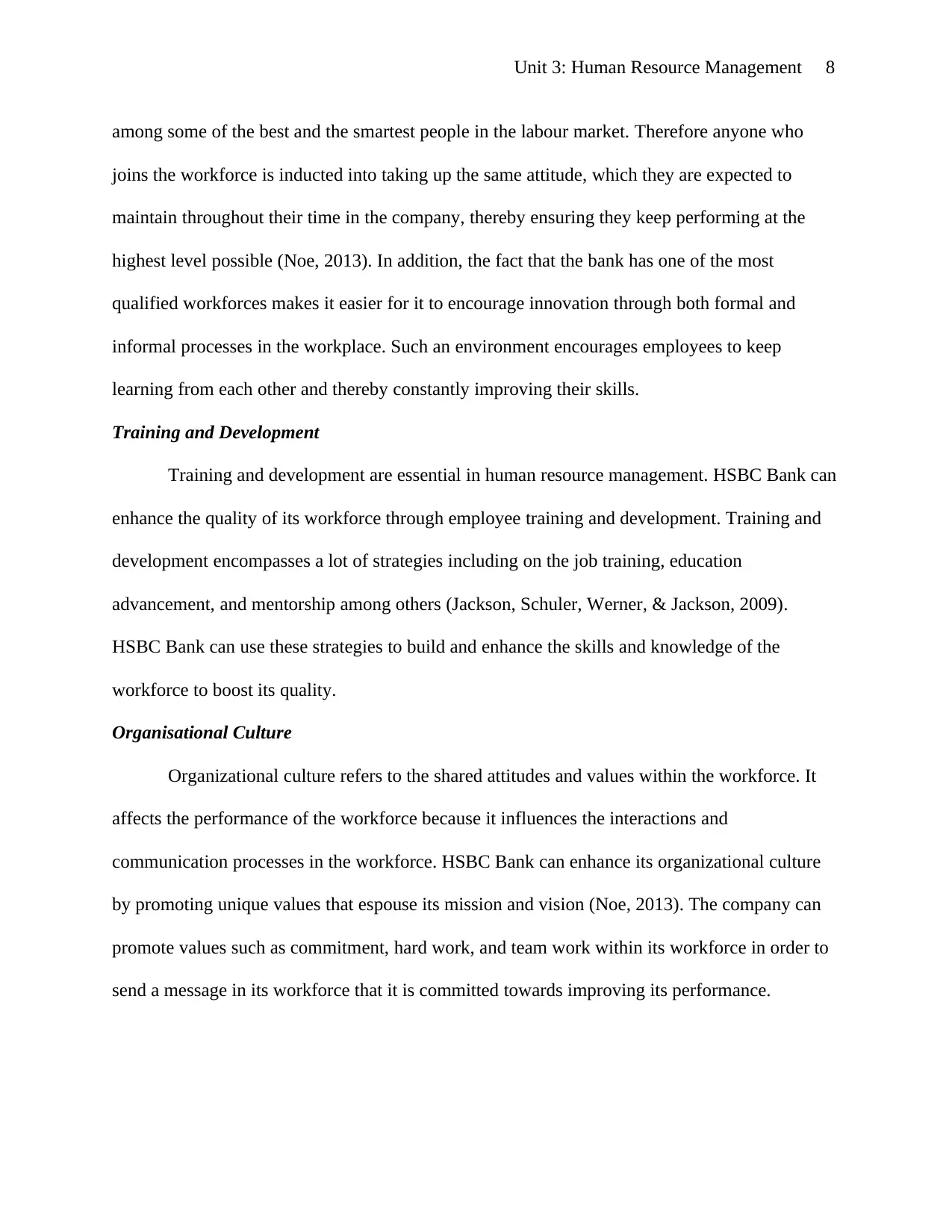
Unit 3: Human Resource Management 8
among some of the best and the smartest people in the labour market. Therefore anyone who
joins the workforce is inducted into taking up the same attitude, which they are expected to
maintain throughout their time in the company, thereby ensuring they keep performing at the
highest level possible (Noe, 2013). In addition, the fact that the bank has one of the most
qualified workforces makes it easier for it to encourage innovation through both formal and
informal processes in the workplace. Such an environment encourages employees to keep
learning from each other and thereby constantly improving their skills.
Training and Development
Training and development are essential in human resource management. HSBC Bank can
enhance the quality of its workforce through employee training and development. Training and
development encompasses a lot of strategies including on the job training, education
advancement, and mentorship among others (Jackson, Schuler, Werner, & Jackson, 2009).
HSBC Bank can use these strategies to build and enhance the skills and knowledge of the
workforce to boost its quality.
Organisational Culture
Organizational culture refers to the shared attitudes and values within the workforce. It
affects the performance of the workforce because it influences the interactions and
communication processes in the workforce. HSBC Bank can enhance its organizational culture
by promoting unique values that espouse its mission and vision (Noe, 2013). The company can
promote values such as commitment, hard work, and team work within its workforce in order to
send a message in its workforce that it is committed towards improving its performance.
among some of the best and the smartest people in the labour market. Therefore anyone who
joins the workforce is inducted into taking up the same attitude, which they are expected to
maintain throughout their time in the company, thereby ensuring they keep performing at the
highest level possible (Noe, 2013). In addition, the fact that the bank has one of the most
qualified workforces makes it easier for it to encourage innovation through both formal and
informal processes in the workplace. Such an environment encourages employees to keep
learning from each other and thereby constantly improving their skills.
Training and Development
Training and development are essential in human resource management. HSBC Bank can
enhance the quality of its workforce through employee training and development. Training and
development encompasses a lot of strategies including on the job training, education
advancement, and mentorship among others (Jackson, Schuler, Werner, & Jackson, 2009).
HSBC Bank can use these strategies to build and enhance the skills and knowledge of the
workforce to boost its quality.
Organisational Culture
Organizational culture refers to the shared attitudes and values within the workforce. It
affects the performance of the workforce because it influences the interactions and
communication processes in the workforce. HSBC Bank can enhance its organizational culture
by promoting unique values that espouse its mission and vision (Noe, 2013). The company can
promote values such as commitment, hard work, and team work within its workforce in order to
send a message in its workforce that it is committed towards improving its performance.
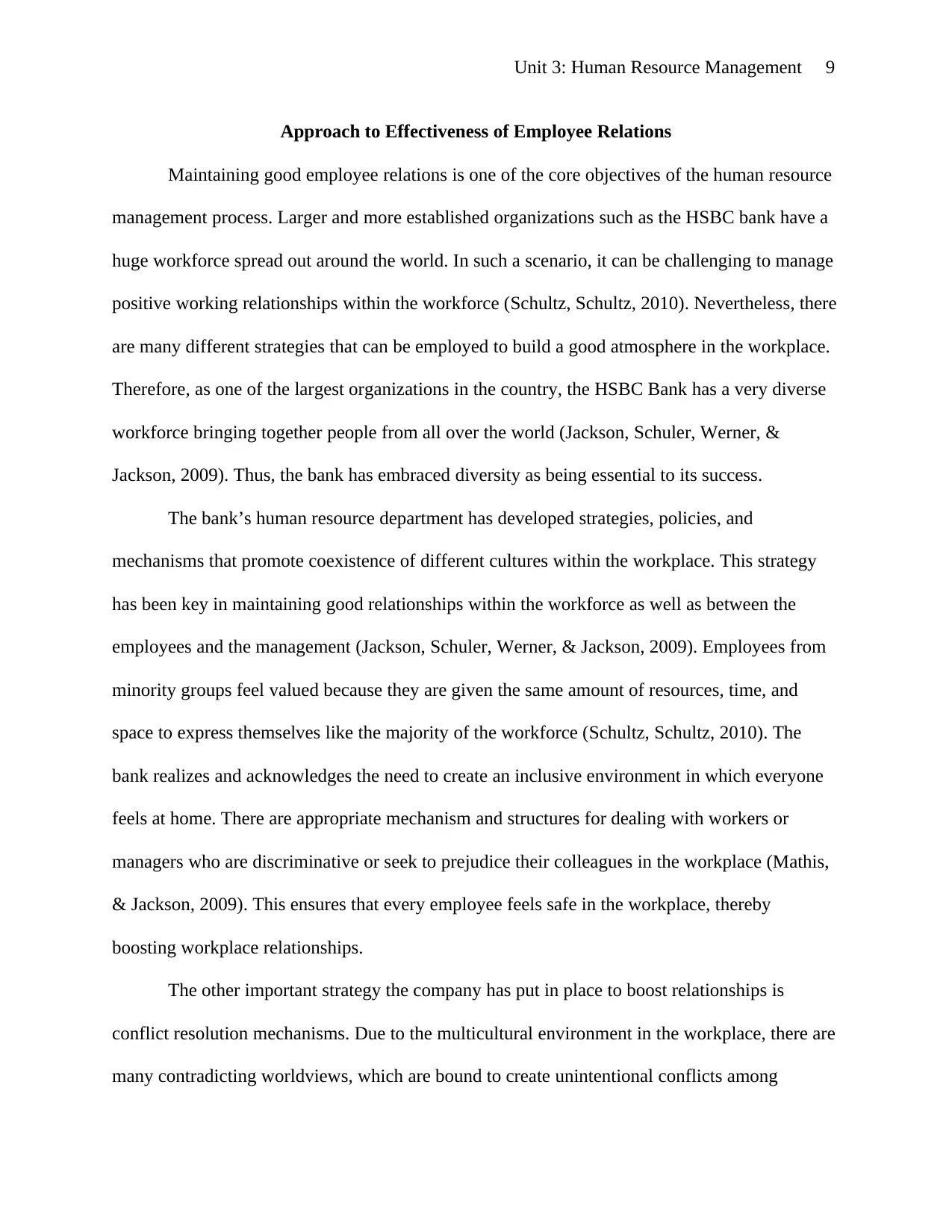
Unit 3: Human Resource Management 9
Approach to Effectiveness of Employee Relations
Maintaining good employee relations is one of the core objectives of the human resource
management process. Larger and more established organizations such as the HSBC bank have a
huge workforce spread out around the world. In such a scenario, it can be challenging to manage
positive working relationships within the workforce (Schultz, Schultz, 2010). Nevertheless, there
are many different strategies that can be employed to build a good atmosphere in the workplace.
Therefore, as one of the largest organizations in the country, the HSBC Bank has a very diverse
workforce bringing together people from all over the world (Jackson, Schuler, Werner, &
Jackson, 2009). Thus, the bank has embraced diversity as being essential to its success.
The bank’s human resource department has developed strategies, policies, and
mechanisms that promote coexistence of different cultures within the workplace. This strategy
has been key in maintaining good relationships within the workforce as well as between the
employees and the management (Jackson, Schuler, Werner, & Jackson, 2009). Employees from
minority groups feel valued because they are given the same amount of resources, time, and
space to express themselves like the majority of the workforce (Schultz, Schultz, 2010). The
bank realizes and acknowledges the need to create an inclusive environment in which everyone
feels at home. There are appropriate mechanism and structures for dealing with workers or
managers who are discriminative or seek to prejudice their colleagues in the workplace (Mathis,
& Jackson, 2009). This ensures that every employee feels safe in the workplace, thereby
boosting workplace relationships.
The other important strategy the company has put in place to boost relationships is
conflict resolution mechanisms. Due to the multicultural environment in the workplace, there are
many contradicting worldviews, which are bound to create unintentional conflicts among
Approach to Effectiveness of Employee Relations
Maintaining good employee relations is one of the core objectives of the human resource
management process. Larger and more established organizations such as the HSBC bank have a
huge workforce spread out around the world. In such a scenario, it can be challenging to manage
positive working relationships within the workforce (Schultz, Schultz, 2010). Nevertheless, there
are many different strategies that can be employed to build a good atmosphere in the workplace.
Therefore, as one of the largest organizations in the country, the HSBC Bank has a very diverse
workforce bringing together people from all over the world (Jackson, Schuler, Werner, &
Jackson, 2009). Thus, the bank has embraced diversity as being essential to its success.
The bank’s human resource department has developed strategies, policies, and
mechanisms that promote coexistence of different cultures within the workplace. This strategy
has been key in maintaining good relationships within the workforce as well as between the
employees and the management (Jackson, Schuler, Werner, & Jackson, 2009). Employees from
minority groups feel valued because they are given the same amount of resources, time, and
space to express themselves like the majority of the workforce (Schultz, Schultz, 2010). The
bank realizes and acknowledges the need to create an inclusive environment in which everyone
feels at home. There are appropriate mechanism and structures for dealing with workers or
managers who are discriminative or seek to prejudice their colleagues in the workplace (Mathis,
& Jackson, 2009). This ensures that every employee feels safe in the workplace, thereby
boosting workplace relationships.
The other important strategy the company has put in place to boost relationships is
conflict resolution mechanisms. Due to the multicultural environment in the workplace, there are
many contradicting worldviews, which are bound to create unintentional conflicts among
⊘ This is a preview!⊘
Do you want full access?
Subscribe today to unlock all pages.

Trusted by 1+ million students worldwide
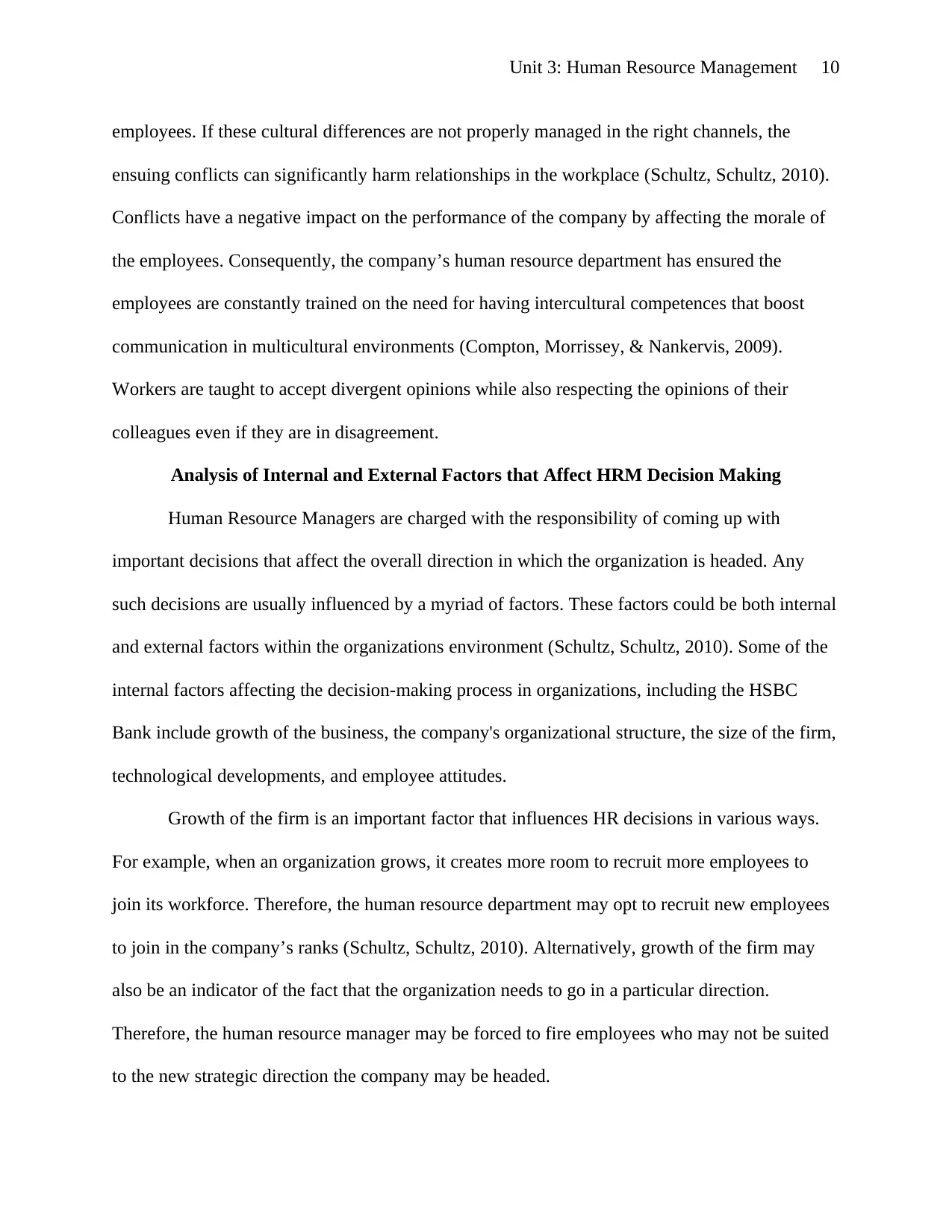
Unit 3: Human Resource Management 10
employees. If these cultural differences are not properly managed in the right channels, the
ensuing conflicts can significantly harm relationships in the workplace (Schultz, Schultz, 2010).
Conflicts have a negative impact on the performance of the company by affecting the morale of
the employees. Consequently, the company’s human resource department has ensured the
employees are constantly trained on the need for having intercultural competences that boost
communication in multicultural environments (Compton, Morrissey, & Nankervis, 2009).
Workers are taught to accept divergent opinions while also respecting the opinions of their
colleagues even if they are in disagreement.
Analysis of Internal and External Factors that Affect HRM Decision Making
Human Resource Managers are charged with the responsibility of coming up with
important decisions that affect the overall direction in which the organization is headed. Any
such decisions are usually influenced by a myriad of factors. These factors could be both internal
and external factors within the organizations environment (Schultz, Schultz, 2010). Some of the
internal factors affecting the decision-making process in organizations, including the HSBC
Bank include growth of the business, the company's organizational structure, the size of the firm,
technological developments, and employee attitudes.
Growth of the firm is an important factor that influences HR decisions in various ways.
For example, when an organization grows, it creates more room to recruit more employees to
join its workforce. Therefore, the human resource department may opt to recruit new employees
to join in the company’s ranks (Schultz, Schultz, 2010). Alternatively, growth of the firm may
also be an indicator of the fact that the organization needs to go in a particular direction.
Therefore, the human resource manager may be forced to fire employees who may not be suited
to the new strategic direction the company may be headed.
employees. If these cultural differences are not properly managed in the right channels, the
ensuing conflicts can significantly harm relationships in the workplace (Schultz, Schultz, 2010).
Conflicts have a negative impact on the performance of the company by affecting the morale of
the employees. Consequently, the company’s human resource department has ensured the
employees are constantly trained on the need for having intercultural competences that boost
communication in multicultural environments (Compton, Morrissey, & Nankervis, 2009).
Workers are taught to accept divergent opinions while also respecting the opinions of their
colleagues even if they are in disagreement.
Analysis of Internal and External Factors that Affect HRM Decision Making
Human Resource Managers are charged with the responsibility of coming up with
important decisions that affect the overall direction in which the organization is headed. Any
such decisions are usually influenced by a myriad of factors. These factors could be both internal
and external factors within the organizations environment (Schultz, Schultz, 2010). Some of the
internal factors affecting the decision-making process in organizations, including the HSBC
Bank include growth of the business, the company's organizational structure, the size of the firm,
technological developments, and employee attitudes.
Growth of the firm is an important factor that influences HR decisions in various ways.
For example, when an organization grows, it creates more room to recruit more employees to
join its workforce. Therefore, the human resource department may opt to recruit new employees
to join in the company’s ranks (Schultz, Schultz, 2010). Alternatively, growth of the firm may
also be an indicator of the fact that the organization needs to go in a particular direction.
Therefore, the human resource manager may be forced to fire employees who may not be suited
to the new strategic direction the company may be headed.
Paraphrase This Document
Need a fresh take? Get an instant paraphrase of this document with our AI Paraphraser
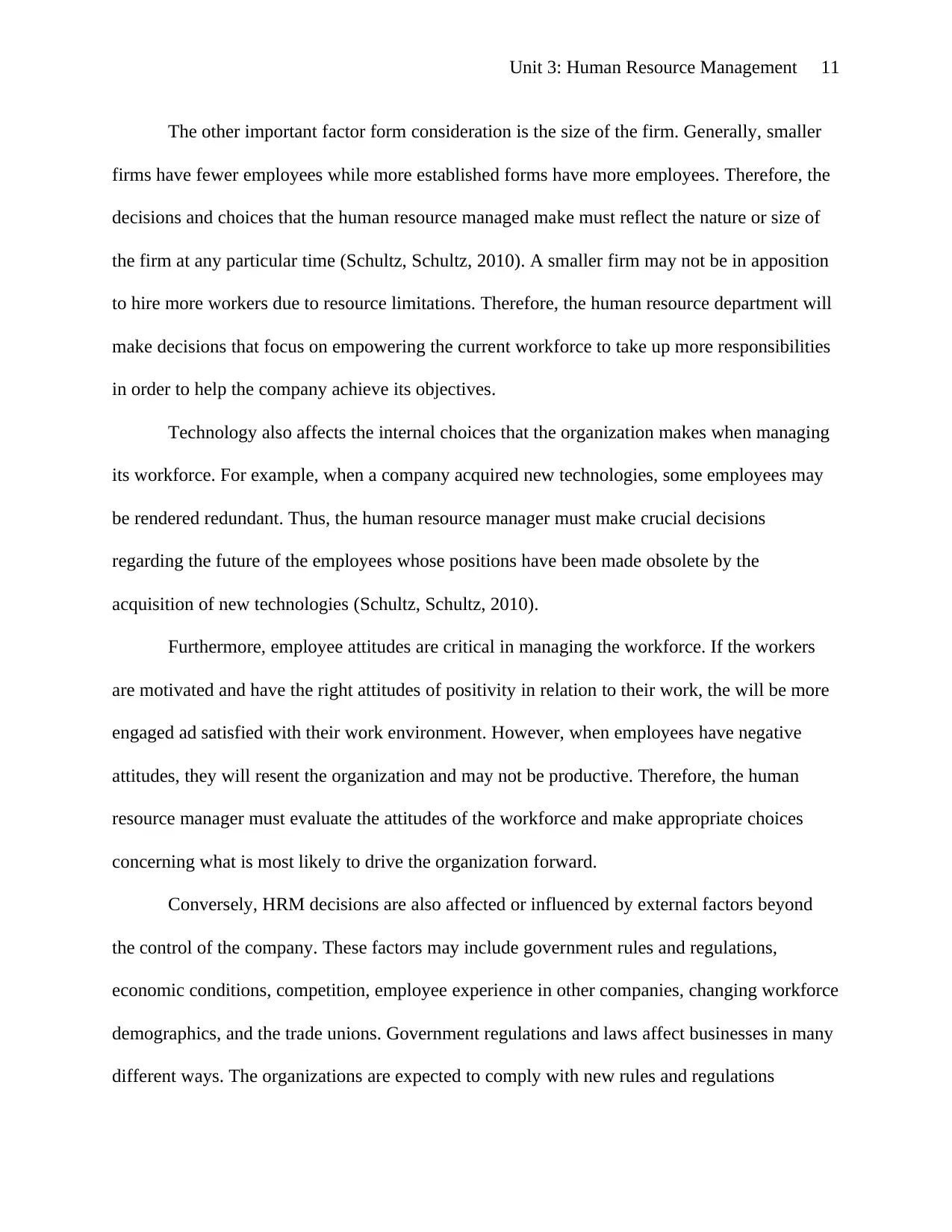
Unit 3: Human Resource Management 11
The other important factor form consideration is the size of the firm. Generally, smaller
firms have fewer employees while more established forms have more employees. Therefore, the
decisions and choices that the human resource managed make must reflect the nature or size of
the firm at any particular time (Schultz, Schultz, 2010). A smaller firm may not be in apposition
to hire more workers due to resource limitations. Therefore, the human resource department will
make decisions that focus on empowering the current workforce to take up more responsibilities
in order to help the company achieve its objectives.
Technology also affects the internal choices that the organization makes when managing
its workforce. For example, when a company acquired new technologies, some employees may
be rendered redundant. Thus, the human resource manager must make crucial decisions
regarding the future of the employees whose positions have been made obsolete by the
acquisition of new technologies (Schultz, Schultz, 2010).
Furthermore, employee attitudes are critical in managing the workforce. If the workers
are motivated and have the right attitudes of positivity in relation to their work, the will be more
engaged ad satisfied with their work environment. However, when employees have negative
attitudes, they will resent the organization and may not be productive. Therefore, the human
resource manager must evaluate the attitudes of the workforce and make appropriate choices
concerning what is most likely to drive the organization forward.
Conversely, HRM decisions are also affected or influenced by external factors beyond
the control of the company. These factors may include government rules and regulations,
economic conditions, competition, employee experience in other companies, changing workforce
demographics, and the trade unions. Government regulations and laws affect businesses in many
different ways. The organizations are expected to comply with new rules and regulations
The other important factor form consideration is the size of the firm. Generally, smaller
firms have fewer employees while more established forms have more employees. Therefore, the
decisions and choices that the human resource managed make must reflect the nature or size of
the firm at any particular time (Schultz, Schultz, 2010). A smaller firm may not be in apposition
to hire more workers due to resource limitations. Therefore, the human resource department will
make decisions that focus on empowering the current workforce to take up more responsibilities
in order to help the company achieve its objectives.
Technology also affects the internal choices that the organization makes when managing
its workforce. For example, when a company acquired new technologies, some employees may
be rendered redundant. Thus, the human resource manager must make crucial decisions
regarding the future of the employees whose positions have been made obsolete by the
acquisition of new technologies (Schultz, Schultz, 2010).
Furthermore, employee attitudes are critical in managing the workforce. If the workers
are motivated and have the right attitudes of positivity in relation to their work, the will be more
engaged ad satisfied with their work environment. However, when employees have negative
attitudes, they will resent the organization and may not be productive. Therefore, the human
resource manager must evaluate the attitudes of the workforce and make appropriate choices
concerning what is most likely to drive the organization forward.
Conversely, HRM decisions are also affected or influenced by external factors beyond
the control of the company. These factors may include government rules and regulations,
economic conditions, competition, employee experience in other companies, changing workforce
demographics, and the trade unions. Government regulations and laws affect businesses in many
different ways. The organizations are expected to comply with new rules and regulations
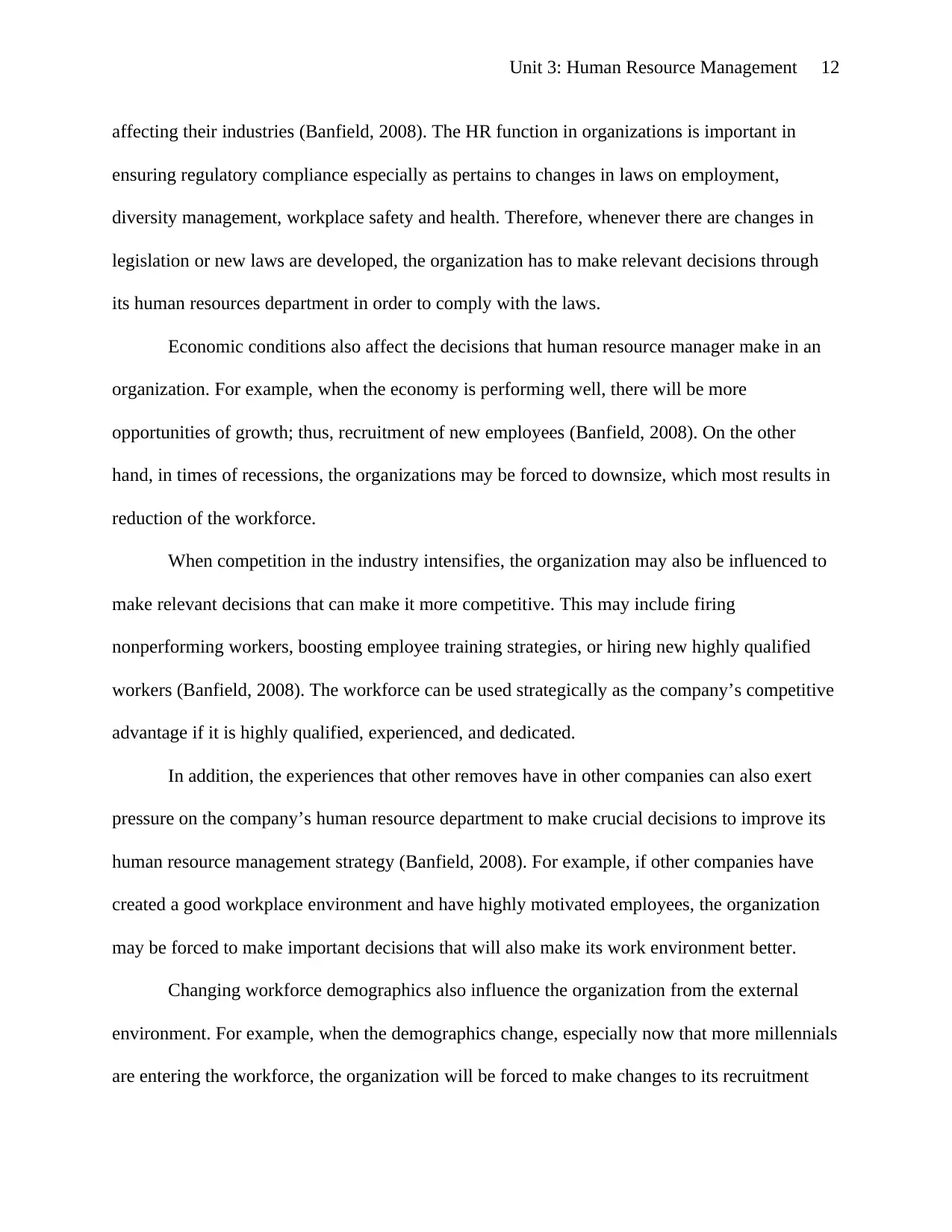
Unit 3: Human Resource Management 12
affecting their industries (Banfield, 2008). The HR function in organizations is important in
ensuring regulatory compliance especially as pertains to changes in laws on employment,
diversity management, workplace safety and health. Therefore, whenever there are changes in
legislation or new laws are developed, the organization has to make relevant decisions through
its human resources department in order to comply with the laws.
Economic conditions also affect the decisions that human resource manager make in an
organization. For example, when the economy is performing well, there will be more
opportunities of growth; thus, recruitment of new employees (Banfield, 2008). On the other
hand, in times of recessions, the organizations may be forced to downsize, which most results in
reduction of the workforce.
When competition in the industry intensifies, the organization may also be influenced to
make relevant decisions that can make it more competitive. This may include firing
nonperforming workers, boosting employee training strategies, or hiring new highly qualified
workers (Banfield, 2008). The workforce can be used strategically as the company’s competitive
advantage if it is highly qualified, experienced, and dedicated.
In addition, the experiences that other removes have in other companies can also exert
pressure on the company’s human resource department to make crucial decisions to improve its
human resource management strategy (Banfield, 2008). For example, if other companies have
created a good workplace environment and have highly motivated employees, the organization
may be forced to make important decisions that will also make its work environment better.
Changing workforce demographics also influence the organization from the external
environment. For example, when the demographics change, especially now that more millennials
are entering the workforce, the organization will be forced to make changes to its recruitment
affecting their industries (Banfield, 2008). The HR function in organizations is important in
ensuring regulatory compliance especially as pertains to changes in laws on employment,
diversity management, workplace safety and health. Therefore, whenever there are changes in
legislation or new laws are developed, the organization has to make relevant decisions through
its human resources department in order to comply with the laws.
Economic conditions also affect the decisions that human resource manager make in an
organization. For example, when the economy is performing well, there will be more
opportunities of growth; thus, recruitment of new employees (Banfield, 2008). On the other
hand, in times of recessions, the organizations may be forced to downsize, which most results in
reduction of the workforce.
When competition in the industry intensifies, the organization may also be influenced to
make relevant decisions that can make it more competitive. This may include firing
nonperforming workers, boosting employee training strategies, or hiring new highly qualified
workers (Banfield, 2008). The workforce can be used strategically as the company’s competitive
advantage if it is highly qualified, experienced, and dedicated.
In addition, the experiences that other removes have in other companies can also exert
pressure on the company’s human resource department to make crucial decisions to improve its
human resource management strategy (Banfield, 2008). For example, if other companies have
created a good workplace environment and have highly motivated employees, the organization
may be forced to make important decisions that will also make its work environment better.
Changing workforce demographics also influence the organization from the external
environment. For example, when the demographics change, especially now that more millennials
are entering the workforce, the organization will be forced to make changes to its recruitment
⊘ This is a preview!⊘
Do you want full access?
Subscribe today to unlock all pages.

Trusted by 1+ million students worldwide
1 out of 18
Related Documents
Your All-in-One AI-Powered Toolkit for Academic Success.
+13062052269
info@desklib.com
Available 24*7 on WhatsApp / Email
![[object Object]](/_next/static/media/star-bottom.7253800d.svg)
Unlock your academic potential
Copyright © 2020–2025 A2Z Services. All Rights Reserved. Developed and managed by ZUCOL.





